Comprehensive Report on Employment Relations in New Zealand
VerifiedAdded on 2021/04/24
|7
|1470
|45
Report
AI Summary
This report provides a comprehensive overview of employment relations in New Zealand, examining the historical context, key legislation, and the roles of various stakeholders. It begins by discussing the political, social, economic, and theoretical influences on the development of New Zealand's employment relations, including the impact of the first Labour government, economic factors, and ideologies like labour process theory. The report then delves into the Employment Relations Act (ERA) 2000, outlining the duties and responsibilities of both employers and employees. It also covers other relevant acts, such as the Holidays Act, Wage Protection Act, and Minimum Wage Act. Furthermore, the report analyzes mechanisms for individual and collective bargaining, focusing on mediation as a primary dispute resolution method. It defines strikes and lockouts, clarifying their legality, and explains the concept of good faith in employment relations. Finally, the report explores the roles of state institutions, including the Employment Authority, police, judiciary, and Labour Inspector, in the employment relationship. References are also included.

Running head: EMPLOYMENT RELATION IN NEW ZEALAND
Employment Relation in New Zealand
Name
Institution
Employment Relation in New Zealand
Name
Institution
Paraphrase This Document
Need a fresh take? Get an instant paraphrase of this document with our AI Paraphraser
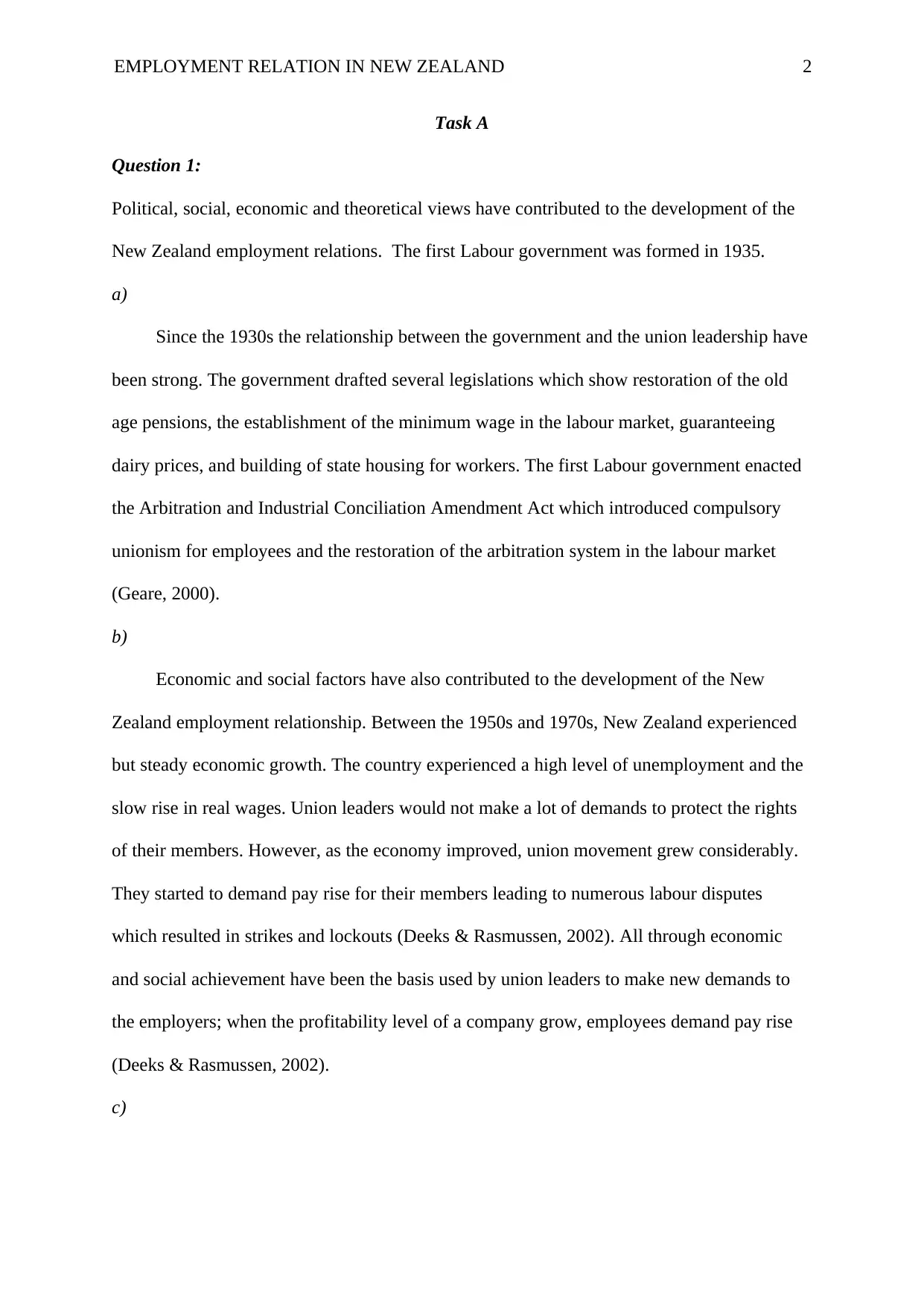
EMPLOYMENT RELATION IN NEW ZEALAND 2
Task A
Question 1:
Political, social, economic and theoretical views have contributed to the development of the
New Zealand employment relations. The first Labour government was formed in 1935.
a)
Since the 1930s the relationship between the government and the union leadership have
been strong. The government drafted several legislations which show restoration of the old
age pensions, the establishment of the minimum wage in the labour market, guaranteeing
dairy prices, and building of state housing for workers. The first Labour government enacted
the Arbitration and Industrial Conciliation Amendment Act which introduced compulsory
unionism for employees and the restoration of the arbitration system in the labour market
(Geare, 2000).
b)
Economic and social factors have also contributed to the development of the New
Zealand employment relationship. Between the 1950s and 1970s, New Zealand experienced
but steady economic growth. The country experienced a high level of unemployment and the
slow rise in real wages. Union leaders would not make a lot of demands to protect the rights
of their members. However, as the economy improved, union movement grew considerably.
They started to demand pay rise for their members leading to numerous labour disputes
which resulted in strikes and lockouts (Deeks & Rasmussen, 2002). All through economic
and social achievement have been the basis used by union leaders to make new demands to
the employers; when the profitability level of a company grow, employees demand pay rise
(Deeks & Rasmussen, 2002).
c)
Task A
Question 1:
Political, social, economic and theoretical views have contributed to the development of the
New Zealand employment relations. The first Labour government was formed in 1935.
a)
Since the 1930s the relationship between the government and the union leadership have
been strong. The government drafted several legislations which show restoration of the old
age pensions, the establishment of the minimum wage in the labour market, guaranteeing
dairy prices, and building of state housing for workers. The first Labour government enacted
the Arbitration and Industrial Conciliation Amendment Act which introduced compulsory
unionism for employees and the restoration of the arbitration system in the labour market
(Geare, 2000).
b)
Economic and social factors have also contributed to the development of the New
Zealand employment relationship. Between the 1950s and 1970s, New Zealand experienced
but steady economic growth. The country experienced a high level of unemployment and the
slow rise in real wages. Union leaders would not make a lot of demands to protect the rights
of their members. However, as the economy improved, union movement grew considerably.
They started to demand pay rise for their members leading to numerous labour disputes
which resulted in strikes and lockouts (Deeks & Rasmussen, 2002). All through economic
and social achievement have been the basis used by union leaders to make new demands to
the employers; when the profitability level of a company grow, employees demand pay rise
(Deeks & Rasmussen, 2002).
c)
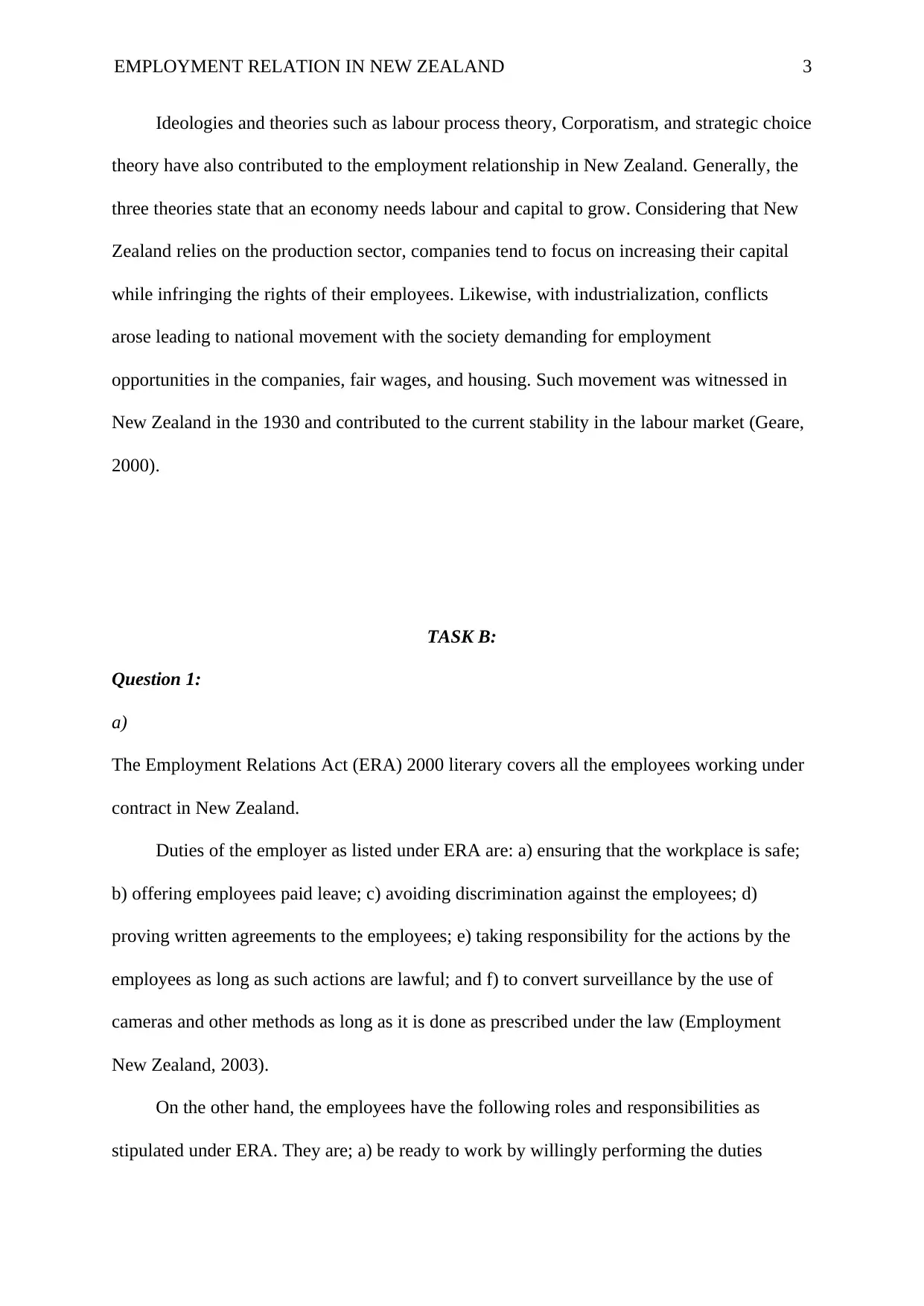
EMPLOYMENT RELATION IN NEW ZEALAND 3
Ideologies and theories such as labour process theory, Corporatism, and strategic choice
theory have also contributed to the employment relationship in New Zealand. Generally, the
three theories state that an economy needs labour and capital to grow. Considering that New
Zealand relies on the production sector, companies tend to focus on increasing their capital
while infringing the rights of their employees. Likewise, with industrialization, conflicts
arose leading to national movement with the society demanding for employment
opportunities in the companies, fair wages, and housing. Such movement was witnessed in
New Zealand in the 1930 and contributed to the current stability in the labour market (Geare,
2000).
TASK B:
Question 1:
a)
The Employment Relations Act (ERA) 2000 literary covers all the employees working under
contract in New Zealand.
Duties of the employer as listed under ERA are: a) ensuring that the workplace is safe;
b) offering employees paid leave; c) avoiding discrimination against the employees; d)
proving written agreements to the employees; e) taking responsibility for the actions by the
employees as long as such actions are lawful; and f) to convert surveillance by the use of
cameras and other methods as long as it is done as prescribed under the law (Employment
New Zealand, 2003).
On the other hand, the employees have the following roles and responsibilities as
stipulated under ERA. They are; a) be ready to work by willingly performing the duties
Ideologies and theories such as labour process theory, Corporatism, and strategic choice
theory have also contributed to the employment relationship in New Zealand. Generally, the
three theories state that an economy needs labour and capital to grow. Considering that New
Zealand relies on the production sector, companies tend to focus on increasing their capital
while infringing the rights of their employees. Likewise, with industrialization, conflicts
arose leading to national movement with the society demanding for employment
opportunities in the companies, fair wages, and housing. Such movement was witnessed in
New Zealand in the 1930 and contributed to the current stability in the labour market (Geare,
2000).
TASK B:
Question 1:
a)
The Employment Relations Act (ERA) 2000 literary covers all the employees working under
contract in New Zealand.
Duties of the employer as listed under ERA are: a) ensuring that the workplace is safe;
b) offering employees paid leave; c) avoiding discrimination against the employees; d)
proving written agreements to the employees; e) taking responsibility for the actions by the
employees as long as such actions are lawful; and f) to convert surveillance by the use of
cameras and other methods as long as it is done as prescribed under the law (Employment
New Zealand, 2003).
On the other hand, the employees have the following roles and responsibilities as
stipulated under ERA. They are; a) be ready to work by willingly performing the duties
⊘ This is a preview!⊘
Do you want full access?
Subscribe today to unlock all pages.

Trusted by 1+ million students worldwide
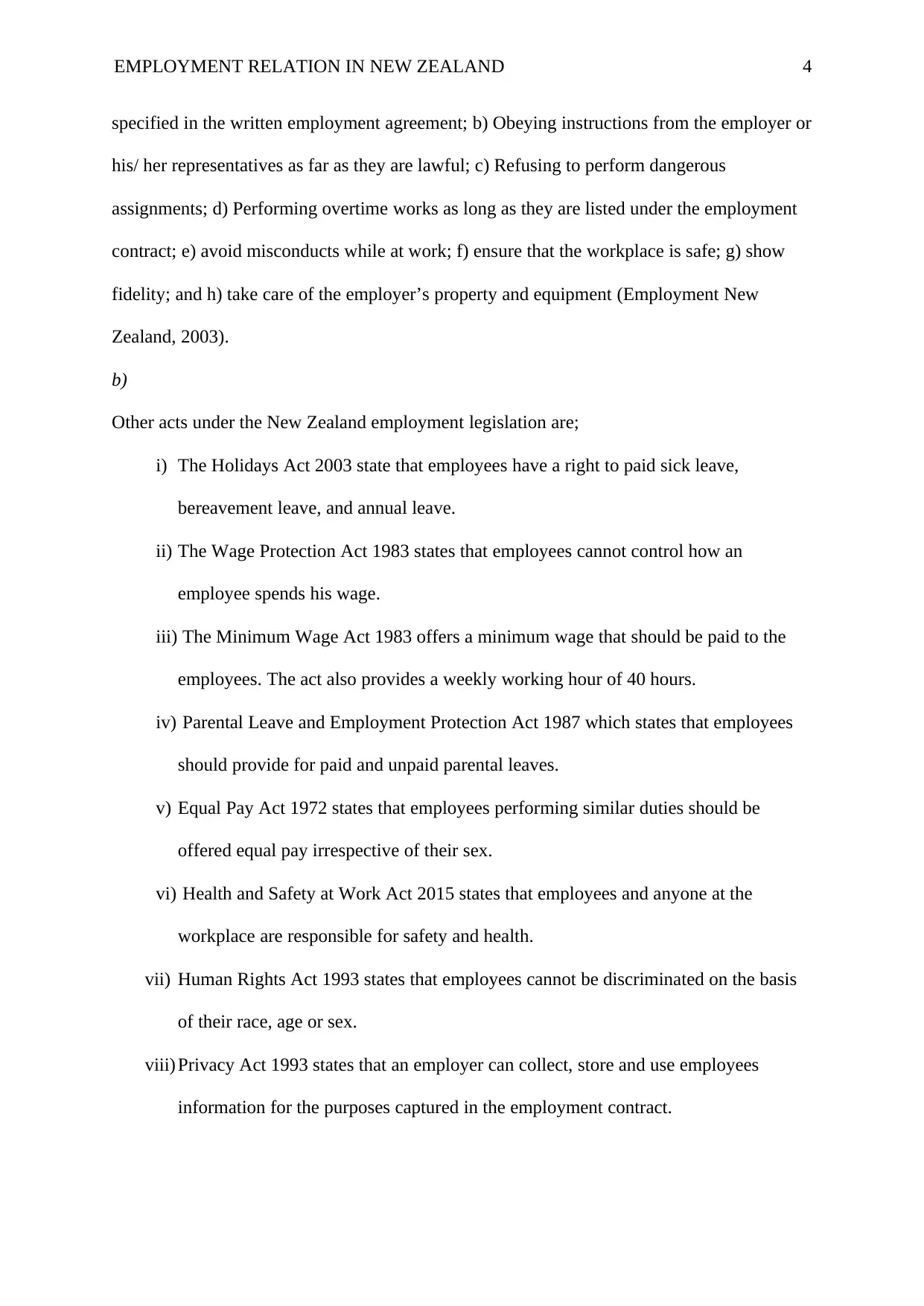
EMPLOYMENT RELATION IN NEW ZEALAND 4
specified in the written employment agreement; b) Obeying instructions from the employer or
his/ her representatives as far as they are lawful; c) Refusing to perform dangerous
assignments; d) Performing overtime works as long as they are listed under the employment
contract; e) avoid misconducts while at work; f) ensure that the workplace is safe; g) show
fidelity; and h) take care of the employer’s property and equipment (Employment New
Zealand, 2003).
b)
Other acts under the New Zealand employment legislation are;
i) The Holidays Act 2003 state that employees have a right to paid sick leave,
bereavement leave, and annual leave.
ii) The Wage Protection Act 1983 states that employees cannot control how an
employee spends his wage.
iii) The Minimum Wage Act 1983 offers a minimum wage that should be paid to the
employees. The act also provides a weekly working hour of 40 hours.
iv) Parental Leave and Employment Protection Act 1987 which states that employees
should provide for paid and unpaid parental leaves.
v) Equal Pay Act 1972 states that employees performing similar duties should be
offered equal pay irrespective of their sex.
vi) Health and Safety at Work Act 2015 states that employees and anyone at the
workplace are responsible for safety and health.
vii) Human Rights Act 1993 states that employees cannot be discriminated on the basis
of their race, age or sex.
viii) Privacy Act 1993 states that an employer can collect, store and use employees
information for the purposes captured in the employment contract.
specified in the written employment agreement; b) Obeying instructions from the employer or
his/ her representatives as far as they are lawful; c) Refusing to perform dangerous
assignments; d) Performing overtime works as long as they are listed under the employment
contract; e) avoid misconducts while at work; f) ensure that the workplace is safe; g) show
fidelity; and h) take care of the employer’s property and equipment (Employment New
Zealand, 2003).
b)
Other acts under the New Zealand employment legislation are;
i) The Holidays Act 2003 state that employees have a right to paid sick leave,
bereavement leave, and annual leave.
ii) The Wage Protection Act 1983 states that employees cannot control how an
employee spends his wage.
iii) The Minimum Wage Act 1983 offers a minimum wage that should be paid to the
employees. The act also provides a weekly working hour of 40 hours.
iv) Parental Leave and Employment Protection Act 1987 which states that employees
should provide for paid and unpaid parental leaves.
v) Equal Pay Act 1972 states that employees performing similar duties should be
offered equal pay irrespective of their sex.
vi) Health and Safety at Work Act 2015 states that employees and anyone at the
workplace are responsible for safety and health.
vii) Human Rights Act 1993 states that employees cannot be discriminated on the basis
of their race, age or sex.
viii) Privacy Act 1993 states that an employer can collect, store and use employees
information for the purposes captured in the employment contract.
Paraphrase This Document
Need a fresh take? Get an instant paraphrase of this document with our AI Paraphraser
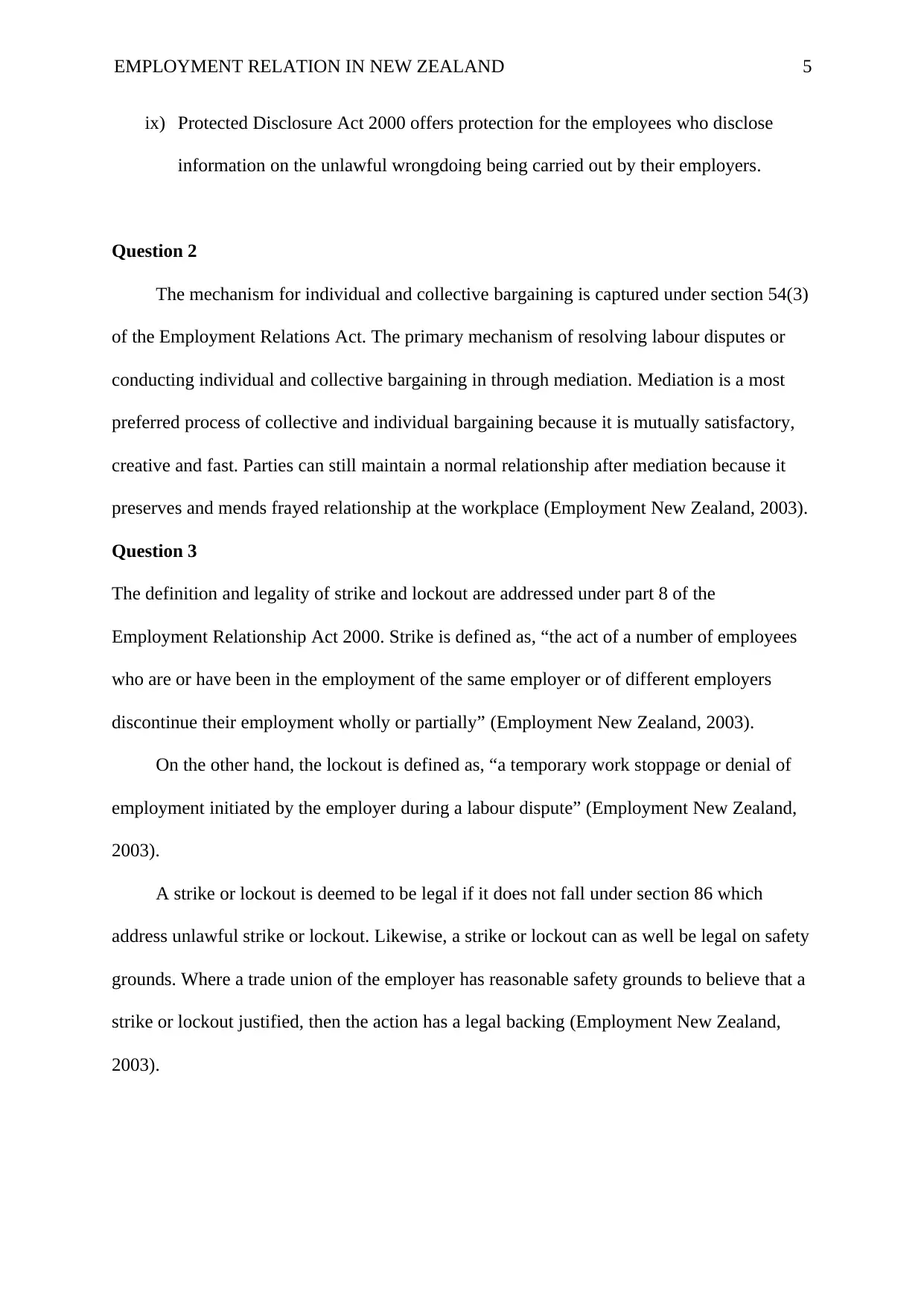
EMPLOYMENT RELATION IN NEW ZEALAND 5
ix) Protected Disclosure Act 2000 offers protection for the employees who disclose
information on the unlawful wrongdoing being carried out by their employers.
Question 2
The mechanism for individual and collective bargaining is captured under section 54(3)
of the Employment Relations Act. The primary mechanism of resolving labour disputes or
conducting individual and collective bargaining in through mediation. Mediation is a most
preferred process of collective and individual bargaining because it is mutually satisfactory,
creative and fast. Parties can still maintain a normal relationship after mediation because it
preserves and mends frayed relationship at the workplace (Employment New Zealand, 2003).
Question 3
The definition and legality of strike and lockout are addressed under part 8 of the
Employment Relationship Act 2000. Strike is defined as, “the act of a number of employees
who are or have been in the employment of the same employer or of different employers
discontinue their employment wholly or partially” (Employment New Zealand, 2003).
On the other hand, the lockout is defined as, “a temporary work stoppage or denial of
employment initiated by the employer during a labour dispute” (Employment New Zealand,
2003).
A strike or lockout is deemed to be legal if it does not fall under section 86 which
address unlawful strike or lockout. Likewise, a strike or lockout can as well be legal on safety
grounds. Where a trade union of the employer has reasonable safety grounds to believe that a
strike or lockout justified, then the action has a legal backing (Employment New Zealand,
2003).
ix) Protected Disclosure Act 2000 offers protection for the employees who disclose
information on the unlawful wrongdoing being carried out by their employers.
Question 2
The mechanism for individual and collective bargaining is captured under section 54(3)
of the Employment Relations Act. The primary mechanism of resolving labour disputes or
conducting individual and collective bargaining in through mediation. Mediation is a most
preferred process of collective and individual bargaining because it is mutually satisfactory,
creative and fast. Parties can still maintain a normal relationship after mediation because it
preserves and mends frayed relationship at the workplace (Employment New Zealand, 2003).
Question 3
The definition and legality of strike and lockout are addressed under part 8 of the
Employment Relationship Act 2000. Strike is defined as, “the act of a number of employees
who are or have been in the employment of the same employer or of different employers
discontinue their employment wholly or partially” (Employment New Zealand, 2003).
On the other hand, the lockout is defined as, “a temporary work stoppage or denial of
employment initiated by the employer during a labour dispute” (Employment New Zealand,
2003).
A strike or lockout is deemed to be legal if it does not fall under section 86 which
address unlawful strike or lockout. Likewise, a strike or lockout can as well be legal on safety
grounds. Where a trade union of the employer has reasonable safety grounds to believe that a
strike or lockout justified, then the action has a legal backing (Employment New Zealand,
2003).
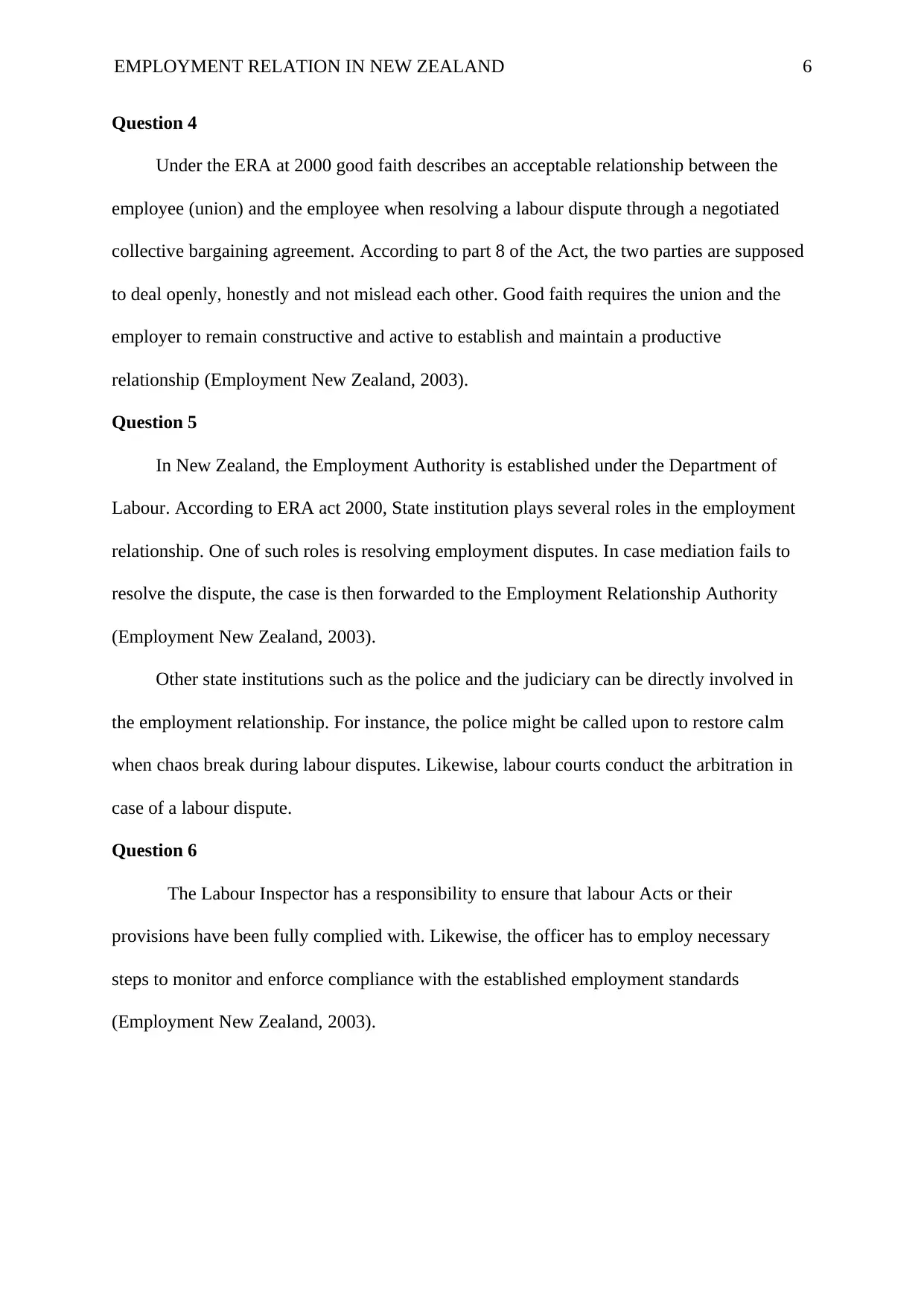
EMPLOYMENT RELATION IN NEW ZEALAND 6
Question 4
Under the ERA at 2000 good faith describes an acceptable relationship between the
employee (union) and the employee when resolving a labour dispute through a negotiated
collective bargaining agreement. According to part 8 of the Act, the two parties are supposed
to deal openly, honestly and not mislead each other. Good faith requires the union and the
employer to remain constructive and active to establish and maintain a productive
relationship (Employment New Zealand, 2003).
Question 5
In New Zealand, the Employment Authority is established under the Department of
Labour. According to ERA act 2000, State institution plays several roles in the employment
relationship. One of such roles is resolving employment disputes. In case mediation fails to
resolve the dispute, the case is then forwarded to the Employment Relationship Authority
(Employment New Zealand, 2003).
Other state institutions such as the police and the judiciary can be directly involved in
the employment relationship. For instance, the police might be called upon to restore calm
when chaos break during labour disputes. Likewise, labour courts conduct the arbitration in
case of a labour dispute.
Question 6
The Labour Inspector has a responsibility to ensure that labour Acts or their
provisions have been fully complied with. Likewise, the officer has to employ necessary
steps to monitor and enforce compliance with the established employment standards
(Employment New Zealand, 2003).
Question 4
Under the ERA at 2000 good faith describes an acceptable relationship between the
employee (union) and the employee when resolving a labour dispute through a negotiated
collective bargaining agreement. According to part 8 of the Act, the two parties are supposed
to deal openly, honestly and not mislead each other. Good faith requires the union and the
employer to remain constructive and active to establish and maintain a productive
relationship (Employment New Zealand, 2003).
Question 5
In New Zealand, the Employment Authority is established under the Department of
Labour. According to ERA act 2000, State institution plays several roles in the employment
relationship. One of such roles is resolving employment disputes. In case mediation fails to
resolve the dispute, the case is then forwarded to the Employment Relationship Authority
(Employment New Zealand, 2003).
Other state institutions such as the police and the judiciary can be directly involved in
the employment relationship. For instance, the police might be called upon to restore calm
when chaos break during labour disputes. Likewise, labour courts conduct the arbitration in
case of a labour dispute.
Question 6
The Labour Inspector has a responsibility to ensure that labour Acts or their
provisions have been fully complied with. Likewise, the officer has to employ necessary
steps to monitor and enforce compliance with the established employment standards
(Employment New Zealand, 2003).
⊘ This is a preview!⊘
Do you want full access?
Subscribe today to unlock all pages.

Trusted by 1+ million students worldwide
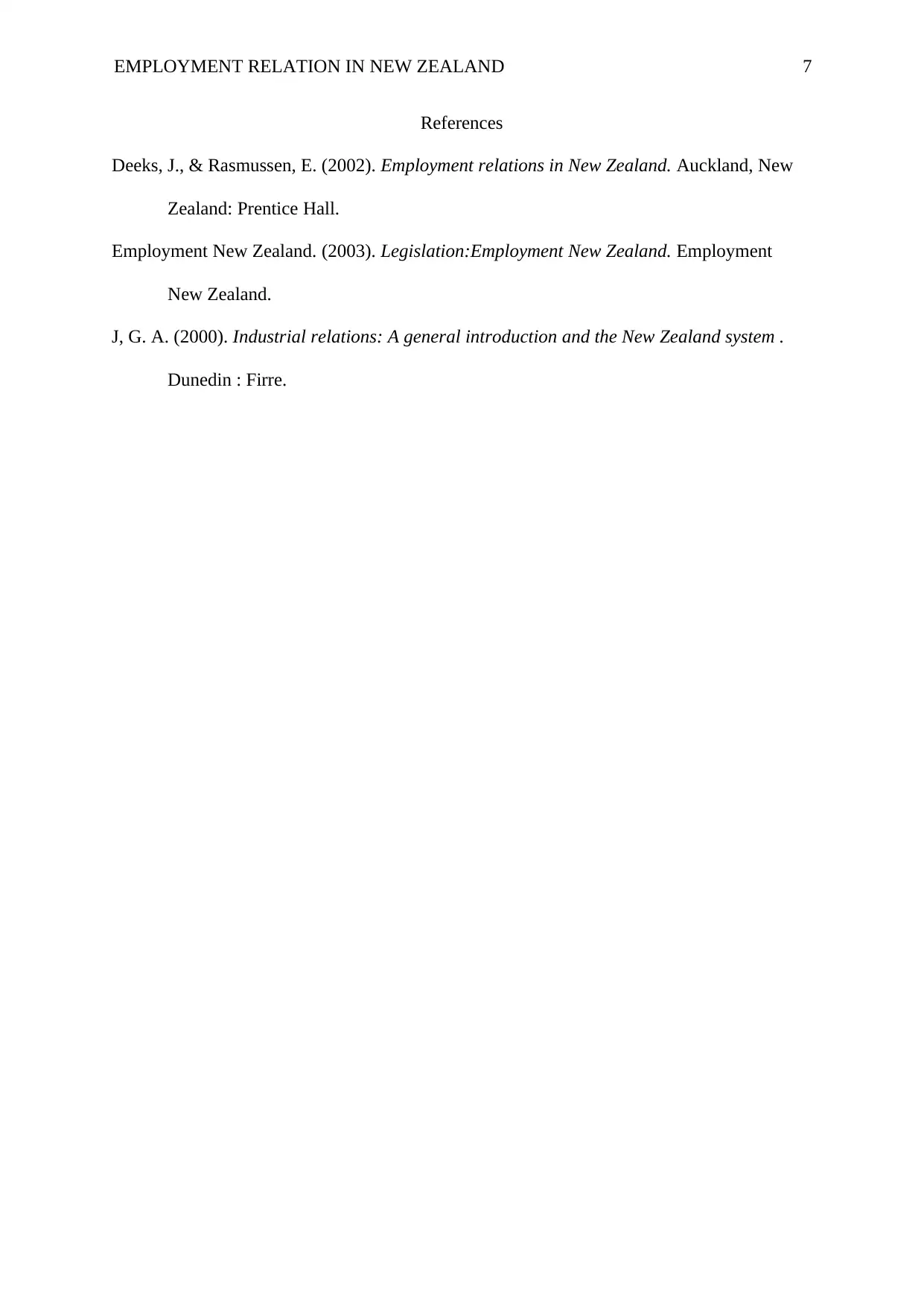
EMPLOYMENT RELATION IN NEW ZEALAND 7
References
Deeks, J., & Rasmussen, E. (2002). Employment relations in New Zealand. Auckland, New
Zealand: Prentice Hall.
Employment New Zealand. (2003). Legislation:Employment New Zealand. Employment
New Zealand.
J, G. A. (2000). Industrial relations: A general introduction and the New Zealand system .
Dunedin : Firre.
References
Deeks, J., & Rasmussen, E. (2002). Employment relations in New Zealand. Auckland, New
Zealand: Prentice Hall.
Employment New Zealand. (2003). Legislation:Employment New Zealand. Employment
New Zealand.
J, G. A. (2000). Industrial relations: A general introduction and the New Zealand system .
Dunedin : Firre.
1 out of 7
Your All-in-One AI-Powered Toolkit for Academic Success.
+13062052269
info@desklib.com
Available 24*7 on WhatsApp / Email
![[object Object]](/_next/static/media/star-bottom.7253800d.svg)
Unlock your academic potential
Copyright © 2020–2025 A2Z Services. All Rights Reserved. Developed and managed by ZUCOL.

